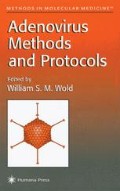Abstract
The selective packaging of adenovirus DNA into a capsid at late times after viral infection raises a number of interesting questions. How is the viral DNA specifically selected from the pool of viral and cellular DNA for encapsidation? Is the packaging process coordinated with viral DNA replication? What protein- protein and protein-DNA interactions are involved in this process? does the virus share a packaging mechanism with one or more of the well-characterized prokaryotic phages? The nonenveloped adenovirus particle contains a protein shell consisting of multiple proteins and a DNA-protein core. The adenovirus particle contains minimally 12 distinct virus-encoded proteins (1) (the structural proteins: hexon, penton, fiber, IIIa, VI, VIII, and IX; the core proteins: V, VII and μ; and the nonstructural proteins: proteinase and terminal protein). The virus capsid is assembled by the association of two different capsomeres: the hexon capsomere, composed of multiple (9–12) hexon molecules, and the penton capsomere, composed of five penton molecules and three fiber proteins. The hexon capsomeres assemble to form the 20 sides of the virion particle, whereas the penton capsomeres comprise the 12 vertices of the virion. The viral core is composed of the linear double-stranded DNA genome, with covalently linked terminal protein at each 5′ terminus, in association with three viral core proteins: V, VII, and u.
Access this chapter
Tax calculation will be finalised at checkout
Purchases are for personal use only
References
Stewart, P. L. and Burnett, R. M. (1995) Adenovirus structure by x-ray crystallography and electron microscopy. Curr Topics Microbiol. Immunol 199/I, 25–38.
D’Halluin, J. C. (1995) Virus assembly. Curr. Topics Microbiol Immunol. 199/I, 47–66.
Hammarskjold, M. L. and Winberg, G. (1980) Encapsidation of adenovirus 16 DNA is directed by a small DNA sequence at the left end of the genome. Cell a20, 787–795.
Tibbetts, C. (1977) Viral DNA sequences from incomplete particles of human adenovirus type 7. Cell 12, 243
Fujisawa, H. and Hearing, P. (1994) Structure, function and specificity of the DNA packaging signals in double-stranded DNA viruses. Semin. Virol. 5, 5–13.
Schmid, S. I. and Hearing, P. (1995) Selective encapsidation of adenovirus DNA. Curr Topics Microbial. Immunol. 199/1, 67–80.
Hearing, P. and Shenk, T. (1986) The adenovirus ElA enhancer contains two functionally distinct domains: One is specific for ElA and the other modulates all early units in cis. Cell 45, 229–236.
Graham, F. L, Smiley, J., Russell, W. C., and Nairu, R. (1977) Characteristics of a human cell line transformed by DNA from human adenovirus type 5. J Gen. Virol. 36, 59–72.
Grable, M. and Hearing, P. (1990) Adenovirus type 5 packaging domain is composed of a repeated element that is functionally redundant. J. Virol 64, 2047–2056
Hearing, P. and Shenk, T. (1983) The adenovirus type 5 ElA transcriptional control region contains a duplicated enhancer element. Cell 33, 695–703.
Stow, N. D. (1981) Cloning a DNA fragment from the left-hand terminus of the adenovirus type 2 genome and its use in site-directed mutagenesis. J. Virol 37, 171–180.
Jones, N and Shenk, T. (1979) Isolation of adenovirus type 5 host range deletion mutants defective for transformation of rat embryo cells. Cell 17, 683–689.
Wigler, M., Silverstein, S, Lee, L S., Pellicer, A., Cheng, Y. C., and Axel, R. (1977) Transfer of purified herpes simplex virus thymidine kinase gene to cultured mouse cells. Cell 11, 223–232.
Maniatis, T., Fritsch, E. F., and Sambrook, J. (1982) Molecular Cloning A Laboratory Manual. Cold Spring Harbor Laboratory, Cold Spring Harbor, NY.
Feinberg, A. P. and Vogelstein, B. (1983) A technique for radiolabeling DNA restriction endonuclease fragments to high specific activity. Anal Biochem 132, 6–13.
Harlow, E. and Lane, D. (1988) Antibodies. A Laboratory Manual Cold Spring Harbor Laboratory, Cold Spring Harbor, NY.
Philipson, L., Lonberg-Holm, K., and Pettersson, U. (1968) Virus-receptor interactations in an adenovirus system. J Virol. 2, 1064–1075
Author information
Authors and Affiliations
Editor information
Editors and Affiliations
Rights and permissions
Copyright information
© 1999 Humana Press Inc., Totowa, NJ
About this protocol
Cite this protocol
Schmid, S.I., Hearing, P. (1999). Adenovirus DNA Packaging. In: Wold, W.S.M. (eds) Adenovirus Methods and Protocols. Methods in Molecular Medicine™, vol 21. Springer, Totowa, NJ. https://doi.org/10.1385/0-89603-551-4:47
Download citation
DOI: https://doi.org/10.1385/0-89603-551-4:47
Publisher Name: Springer, Totowa, NJ
Print ISBN: 978-0-89603-551-5
Online ISBN: 978-1-59259-603-4
eBook Packages: Springer Protocols

